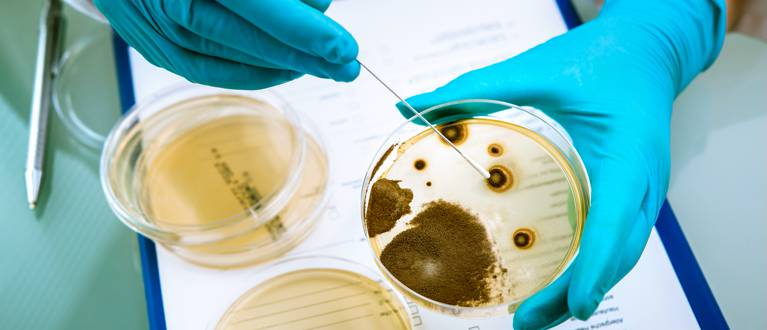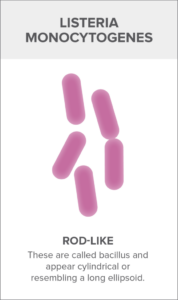Listeria & Listeriosis: Symptoms, Testing and Prevention

We previously examined the causes and impacts of microbiological food contamination, which affects 1 in 6 Americans every year. E-coli and salmonella are two of the most commonly recognized (and contracted) foodborne illnesses, but there is another pathogen that has grown in recognition and transmission since its discovery in 1940: Listeria.
The Center for Disease Control and Prevention (CDC) estimates that Listeria is the third leading cause of death from food poisoning in the United States. On average, 1,600 people get sick from Listeria each year, and about 260 die. Newborn babies, the elderly, and the immunocompromised at are the highest risk.
What is Listeria?
The genus Listeria includes fifteen different species. The most important of which for the food industry is listeria monocytogenes, which is transmitted through contaminated food and results in the disease known as listeriosis. While many species of Listeria can be found in foods and in the food processing environment, listeria monocytogenes is the only species known to affect humans.

Common listeriosis symptoms
According to the CDC, people who contract listeriosis usually report symptoms 1 to 4 weeks after eating contaminated food. In rare cases, listeriosis symptoms have started as early as the same day of exposure or as late as 70 days after exposure.
The most common listeriosis symptoms include fever, muscle aches, headache, stiff neck, confusion, loss of balance, and convulsions.
Pregnant women typically experience only fever and other flu-like symptoms, such as fatigue and muscle aches. However, infections during pregnancy can lead to miscarriage, stillbirth, premature delivery, or life-threatening infection of the newborn.
Who is at risk?
Pregnant women
Pregnant Hispanic women are 24 times more likely than other people to get Listeria infection.
While Listeria can affect anyone, certain groups are at greater risk than others. Pregnant women are 10 times more likely to contract listeriosis.
Older adults
More than half of all Listeria infections occur in people over the age of 65 because their immune systems aren’t able to recognize and rid the body of harmful pathogens as quickly as those under 65. Older adults who take medications to treat chronic conditions such as cancer or diabetes are at even greater risk because these medications weaken the immune system.
People with weakened immune systems
People with medical conditions that impact the immune system including cancer, diabetes, liver or kidney disease, alcoholism, HIV, and AIDS are also at a higher risk of listeriosis. Treatments and medications for these conditions often include steroids or chemotherapy, both of which decrease the body’s ability to fight illness.
Where does Listeria grow?
Listeria is a particularly resilient bacteria that thrives in moist, humid (86-98° F) environments. It also stands apart from other foodborne pathogens because it can grow at refrigerator temperatures (33-40° F) and even survive at temperatures below freezing (32° F). Refrigerated foods that do not have a secondary barrier, such as low moisture or low pH, have the potential to support the growth of listeria monocytogenes. Commonly found in foods such as hot dogs, soft cheeses, unpasteurized milk, pâté, and sliced meats, Listeria is only killed through cooking and pasteurization.
Food products that support listeria growth:
| Processed meat products | Dairy products made from unpasteurized milk |
| Refrigerated smoked seafood | Raw and undercooked sprouts |
| Watermelon | Cantaloupe |
Testing for Listeria
The standard laboratory method for determining if Listeria species are present in a food sample includes an enrichment step, followed by an enzyme-linked immunosorbent assay (ELISA). If a sample is found to be positive using the ELISA method, the enrichment sample is streaked on selective agar plates.
From there, suspect colonies are subjected to biochemical testing. The biochemical profile can be used to determine which species are present in the sample. This process is labor-intensive and requires an experienced analyst who can interpret the samples to get accurate results, which can take up to one week.
Food Safety Testing
Our lab services include listeria tests. View our food safety tests to see Medallion Labs' capabilities.
Test LibraryNew technologies
Qualicon’s BAX® System can be used to detect the presence of Listeria in less than 3 days. The BAX System uses polymerase chain reaction (PCR) technology to detect the presence of pathogens in food and environmental samples. While the ELISA method can only screen for the genus Listeria, the BAX System can screen for both the genus Listeria and specifically for listeria monocytogenes.
In most situations, just confirming that listeria monocytogenes is present in the environment or in a food sample is sufficient to warrant intervention through cleaning, sterilization, and destruction of the food product. In other situations, it may be useful to determine the genetic fingerprint of the species.
The Qualicon RiboPrinter™ can be used to rapidly determine a genetic fingerprint for a number of bacterial species, including Listeria, to aid in investigating the source of a specific Listeria strain and prevent large outbreaks.
Listeria is a dangerous pathogen that can cause serious health risks if left unchecked. Luckily, the risk can be reduced significantly with proper food handling, packaging, and production. If you’re concerned about the presence of listeria in a food sample, or curious about the testing process, connect with Medallion Labs to speak with our team of expert analysts.
Let's Get to Work!
Submit your order online and ship your samples today. If you have questions, we are always here to help.
Medallion Labs+
A food testing program designed with mid-market and enterprise food and ingredient manufacturers in mind.